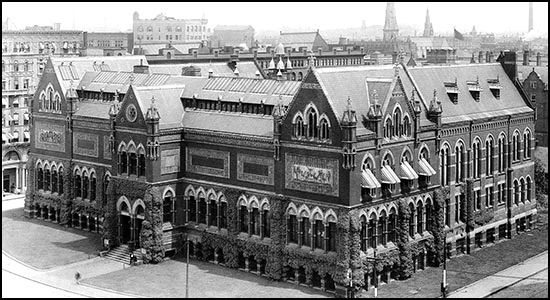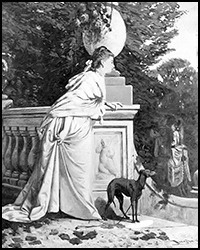


After being exhibited at Boston Museum of Fine Arts in October 1880 and the Pennsylvania Academy of Fine Arts in Philadelphia, Juglaris’s Paris Salon paintings were soon re-displayed at the Boston Art Club in May 1881. They were part of a much larger exhibition that Juglaris mounted with John Ward Dunsmore, a friend from Paris days and a fellow disciple of the eminent artist Thomas Couture. The joint exhibition featured fifty-nine works by Juglaris, including oil paintings, charcoal sketches, watercolors, stained glass window cartoons, and Christmas card designs. Juglaris followed this up the following year with another, albeit much smaller, Boston Art club exhibition strictly focused on the kind of frieze work and decorative design he was commissioned to complete at the palatial mansions of Governor Oliver Ames on Commonwealth Avenue, Calvin B. Prescott of Newton, Massachusetts, and George Barnes of Syracuse, New York.

During his remaining decade in Boston, Juglaris hosted two other major exhibitions of his work, both solo events. In March 1885, he presented for public view another fifty works at the Boston Art Club. It combined previously displayed works with more recent paintings and studies. Drawing “crowds of visitors,” Juglaris’s third major exhibition was held in his Bromfield Street studio in March 1890. Meanwhile, throughout the 1880s Juglaris was represented by one or more works in various exhibitions sponsored by the Charitable Mechanics Association, the Soldiers Home Carnival, and South Boston Art Club. Beyond Boston, Juglaris’s work similarly appeared in exhibitions hosted by the Pennsylvania Academy of Fine Arts in Philadelphia and National Academy of Design in New York City
For the most part Juglaris's joint or solo exhibitions received highly favorable reviews from Boston’s art critics. The Juglaris-Dunsmore exhibition was praised as one of the “most notable art events of the season.” Likewise, Juglaris’s 1885 solo exhibition was lauded as “one of the finest and interesting displays of art work that has been seen in Boston.” Juglaris was further cited as “an artist of singular versatility and fecundity.” He was particularly commended for the warmth and effectiveness of his colors and his adept handling of drapery or clothing which demonstrated “a rare artistic sense.” Further admired was the originality of Juglaris’s compositional technique. Yet mixed with these accolades extolling Juglaris’s “strong natural powers” and skillful technique, was a challenge to his aesthetics, especially in the realm of fine arts.


In the late nineteenth century American culture was increasingly preoccupied with feeling and sentiments and intrigued by psychological motivations. On this score, Juglaris’s work was found deficient. Critics charged that Juglaris’s art lacked any “poetic feeling” or perceptible “unction of feeling” and that it was difficult to get sympathetically interested in his work.” Further fault was found with Juglaris’s female figures which, almost always drawn from live models, were distinguished by a certain solidity and stolidity at odds with the style of the day. In response to the 1881 exhibition, for instance, the art critic of the Boston Herald complained that Juglaris’s “female figures…are of a rather heavy type, too much so for grace and ideal beauty.” Four years later, either he or an immediate successor was expansively reiterating the same concern. According to the Herald critic, Juglaris had rejected all “prettiness and sentimentality.” Any female figures or images of children emanating from his brush were invariably “wholesome and grave in their plainness, [and] rather inclined to rotundity withal. Similar observation led another Boston critic to opine that “Mr. Juglaris’s talent [might lie] seclusively in the direction of decorative work” which he almost invariably rendered “with a certain dignity and largeness of composition that is…effective and impressive.” Similarly, another reviewer from the Boston Post wrote that “we were especially impressed by his power for decorative mural paintings… Mr. Juglaris’s time is much absorbed in teaching but we ought to see more of his work—especially for glass and wall decoration.”
Boston critics also had other concerns about Juglaris’s exhibited body of work. Juglaris raised eyebrows by the casualness with which he exhibited nudes—a practice not yet accepted locally. Another bone of contention was Juglaris’s inclusion in his exhibitions of sketches and preliminary studies. In this matter Juglaris was only following the example of his own teacher, Thomas Couture. But it offended local Boston sensibilities. In one critic’s view, professional etiquette dictated that “an artist should not allow his method to go abroad indecently exposed.” On the other hand, another more charitable critic, observing Juglaris’s pedagogical bent, appreciated him for “taking the public into his studio and into his confidence; he keeps nothing back, but good humoredly confesses his faults and failures, explains his experiments, reveals his processes, and wins our sympathy by his impulsive frankness.”